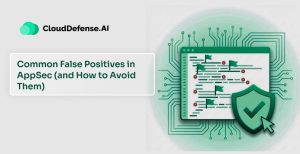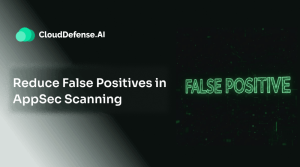Nowadays, most developers rely on AI coding assistants like Cursor and Windsurf to increase the speed and efficiency of software development. Developers leverage these tools to make the most out of them while ensuring high productivity. Although these AI coding assistants make everything easier for developers, it is also introducing many security issues. This is where AppSec is needed.
As Gartner has predicted that by the end of 2025, most code used in software development will be AI-generated. So AI code assistant security for Cursor and Windsurf output has become more important than ever. This article highlights the integration of AI code assistant: Cursor and Windsurf, and how developers can automatically secure the code.
Risks of Relying Solely on AI-Generated Code of Windsurf and Cursor
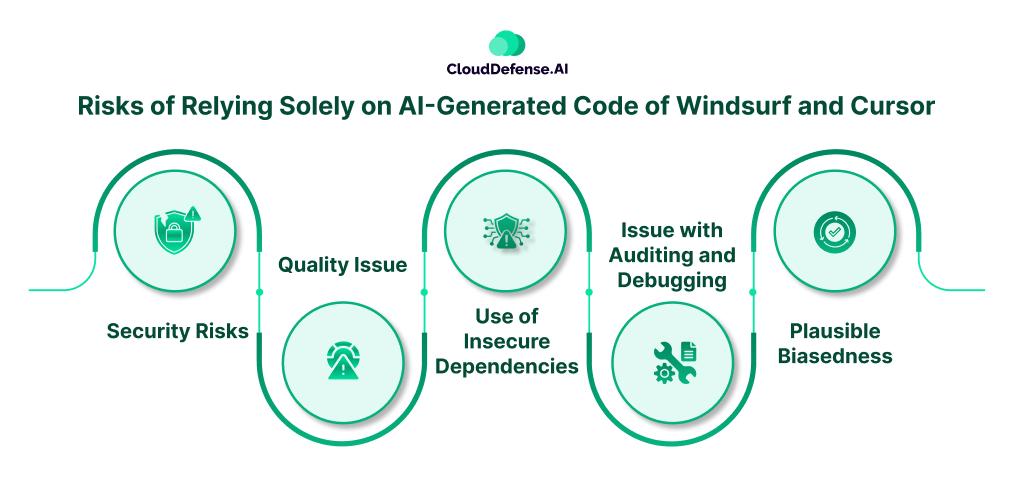
Despite AI code assistants helping developers in streamlining the coding process, they too have many flaws. Relying solely on outputs of Cursor and Windsurf can introduce many risks and compromise the security and quality of the business’s app. Here are the risks that businesses should be aware of:
- Security Risks: The biggest issue in considering the output of Cursor or Windsurf as the final product is the security risk it can bring to the app. Cursor and Windsurf are trained on varying datasets, which include vulnerable codes. Without AppSec for Cursor or Windsurf, malicious attackers can utilise XSS, SQL Injection, or other similar attacks to get access to the development system.
- Quality Issue: Another primary risk developers will face is a lack of code quality if they solely rely on output of AI code assistant tools. The codes are mostly functional, but they often lack the quality that an organization plans to meet. Without proper AppSec and human intervention, it will cause the application to be filled with bugs and difficult to review for security flaws.
- Use of Insecure Dependencies: In many instances, tools like Cursor and Windsurf might utilise insecure dependencies that carry common vulnerabilities. Blindly trusting the outputs of AI coding tools will lead to the addition of insecure segments in the software supply chain.
- Issue with Auditing and Debugging: AI codes often lead to issues in debugging and auditing. Even though Windsurf and Cursor make intelligent code suggestions based on project context, developers often find it difficult to understand. As a result, it becomes a tedious task to debug and identify security flaws manually.
- Plausible Biasedness: There is a possibility that Windsurf and Cursor might have been trained on datasets that have bias. As a result, the tool will generate code accordingly, which will lead to unfair code segments and security flaws in many instances. Applications that work with sensitive data can cause unintentional leakage of sensitive data.
AppSec Tools to Catch Flawed Outputs of Cursor and Windsurf
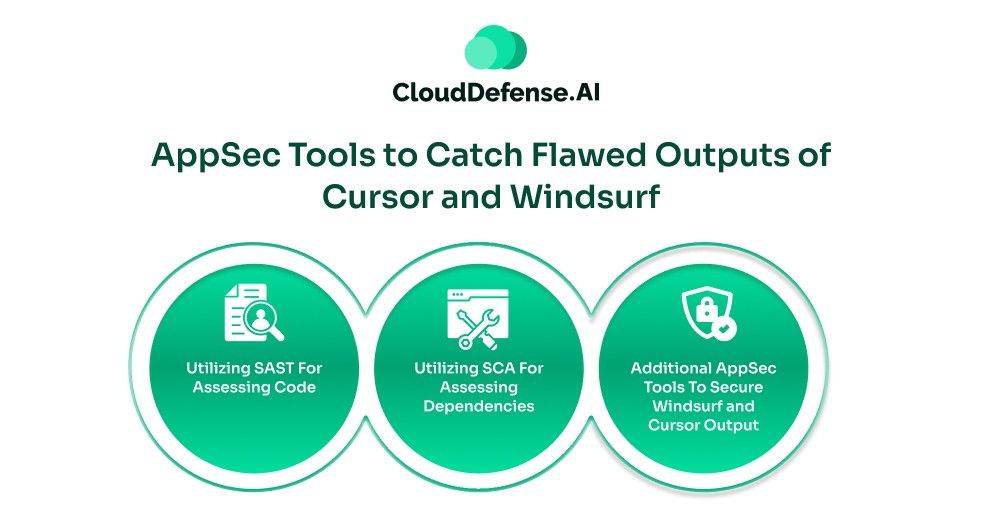
Since developers are relying more on AI-generated code, utilizing AppSec for Cursor and Windsurf has become necessary. Integrating AppSec tools with a shift-left security approach can help security teams find and remediate in the SDLC before they are deployed. SAST and SCA serve as primary AppSec tools that can assure Cursor and Windsurf secure development code.
Utilizing Static Application Security Testing(SAST) For Assessing Code
Integrating SAST tools in the IDE and CI pipeline of the software development process is an efficient way to auto secure code from Cursor and Windsurf. The tool is designed for white box testing, where it assesses all the code of the applications in their build phase. It analyses the structure of codes and compares every code with common vulnerabilities, industry rules, and security policies.
SAST also analyses all the data streams flowing through the application. Thus, it is able to continuously scan to find flawed codes while they are being written. The continuous code scanning in the early stage helps both developers and the security team to remediate issues before they are deployed.
Invariably, it prevents flawed codes or results of insecure coding practices from embedding into the app and making it vulnerable to attack. The SAST ruleset can be tweaked to target common vulnerabilities that often appear in outputs of Cursor and Windsurf.
Besides, it is useful in identifying various common security threats that appear due to flawed code:
- Cross Site Scripting- Cross Site Scripting, or XSS, is a serious vulnerability where attackers utilise malicious data in an AI-code-based website to execute the script. SAST identifies such flawed code that can give rise to malicious data that will lead to XSS.
- Injection Attack: The SAST tool is highly efficient against injection attacks like SQL injection and LDAP injection attacks. It prevents user data from being maliciously used in queries.
- Buffer Overflow: This AppSec tool can proactively identify AI-codes from Cursor and Windsurf that might involve data more than the specified buffer size. It prevents the addition of such code that can cause a crash of the app.
- Secret Exposure: In many instances, AI-generated codes can give away credentials like API or sensitive customer data. This tool prevents developers from using code that carries hardcoded secrets.
Utilizing Software Composition Analysis Tool(SCA) For Assessing Dependencies
AI code assistants like Cursor and Windsurf utilise many open source libraries, containers, and third-party dependencies. Thus, it provides AI codes that attackers can exploit and launch their malicious attack.
Organizations can remediate it by involving SCA tools that analyse all the dependencies in the code. This AppSec tool is integrated into the CI pipeline during the development process for analyzing the codebase. It is also integrated as a plugin in the AI assistant code editors, where it provides security alerts to developers regarding AI code. It is useful for developers to discard AI code having vulnerable dependencies.
SCA assesses all the dependencies in the AI-generated codebase and compares them with all the industry-recognized vulnerability databases. It also compares the dependencies with various licensing information. When they match with known vulnerabilities, it alerts developers and allows coders to select other AI-developed code. In addition to known vulnerabilities, SCA is also useful for identifying:
- Obsolete Dependency: SCA provides highlights regarding any code that utilizes obsolete dependencies, which can lead to security flaws.
- Licensing Issue: This AppSec tool is useful in identifying dependencies having specific licences that might not adhere to the end application’s usage policy. Using AI codes with conflicting license usage can cause serious legal implications.
- Discrepancy in Dependency: It is effective in identifying a flawed package that holds a similar name to that of the internal dependency. Due to a similar name, the malicious package might be requested from a public repository. However, SCA can prevent AI code with malicious dependencies from getting deployed.
Additional AppSec Tools To Automatically Secure Windsurf and Cursor Output
In addition to SCA and SAST, there are other tools that also facilitate Cursor and Windsurf secure development. Here are some tools organizations can utilize:
- Secret Detection Tool: Security teams can deploy secret detection tools in the development stage to prevent sensitive data leakage. This tool can efficiently analyze the repositories and files used by AI code for any hard-coded secrets. It will be highly useful, along with the SAST tool, to specifically prevent any API key or customer information from getting unintentionally deployed.
- Infrastructure as Code Scanning: Organizations relying on IaC can use these scanners to find misconfigurations. IaC scanning is mostly done in the CI/CD pipeline to scan the code to ensure unnecessary infrastructure is not allocated.
Ensuring Human Monitoring, Security Policies, and Safe Coding Practices
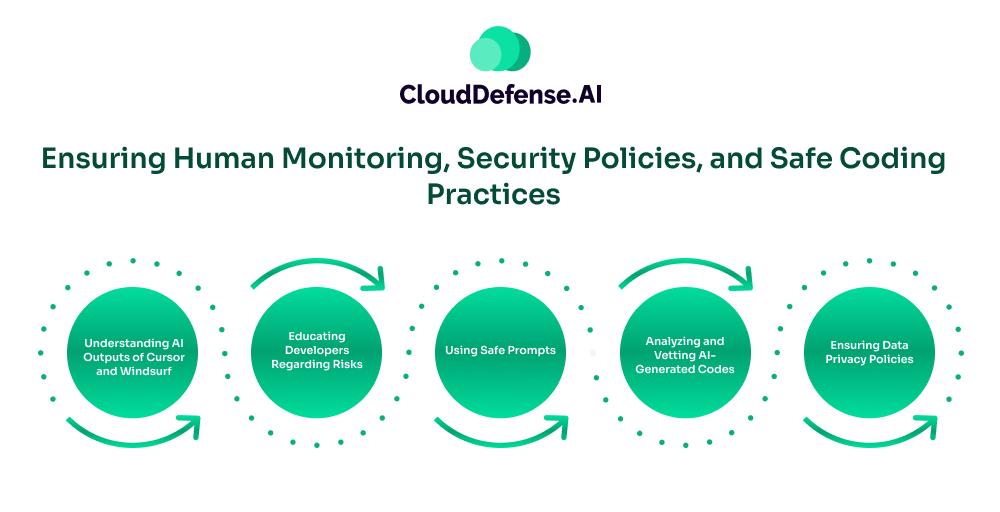
While AppSec tools serve as a primary approach to automatically secure Windsurf and Cursor output, safe coding practice is also vital. In addition, organizations need to utilize human proficiency and security policies to analyze AI-based codes to catch flaws. Here are some approaches organizations should utilize:
- Understanding AI Outputs of Cursor and Windsurf: Developers using Cursor and Windsurf must assess the AI-generated codes before committing them. Both the AI code assistant tools offer the context of the code. Assessing and understanding the code will ensure seamless debugging and recognizing security flaws.
- Educating Developers Regarding Risks: The Organization should conduct workshops to educate developers regarding risks associated with AI codes of Cursor and Windsurf. Most importantly, the workshops should teach how developers can find common flaws associated with the code.
- Using Safe Prompts: Developers need to practice how they can utilize safe prompts for Cursor and Windsurf. Importantly, they need to learn to provide secure prompts that comply with the industry-standard security practices. Developers need to create prompts that involve input validation and should omit specific vulnerabilities.
- Analyzing and Vetting AI-Generated Codes: Developers must specifically analyze the code from Cursor and Windsurf. The codes must be compared with the organization’s security standards to ensure it is safe for deployment. Security policies should be implemented to ensure that all the AI-based code is vetted before they are added.
- Ensuring Data Privacy Policies: Developers, while committing AI code in the codebase, must ensure it adheres to the designated data privacy policies. It is also vital that developers need to involve code practices that maintain compliance with relevant industry regulations.
Conclusion
It goes without saying, developers are greatly benefiting from AI code from Cursor and Windsurf. However, these AI codes are also giving rise to many security flaws. Identifying AI code assistant security issues and automatically securing the AI code is important to ensure an optimum security posture.
AppSec tools, by integrating with CI/CD pipeline and AI code assistant tools, are helping developers to identify many security flaws. However, implementing this approach isn’t simple and requires careful planning. We have highlighted some tools and approaches that can help you secure the output of Windsurf and Cursor while maintaining productivity.

